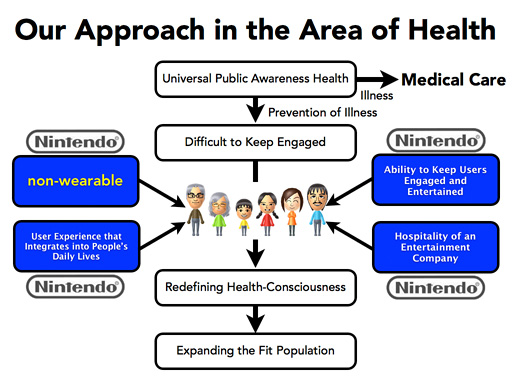They're really just incompetent, what are they thinking with this for example:
As someone who's been working in the area for a couple of years, I can tell you that this is a typical Ambient Assisted Living (AAL) flowchart.
It's a real and expanding market targeted to an expanding demographic (>65 years old), and it's supposed to be the next boom in governmental investment of first-world countries. Also, a big proportion of a developed country's riches is in the 3rd age.
Japan is one of the countries with the oldest population and this is a very big concern for them. It's not a surprise that a big company exploring AAL is coming from there.
So far, most efforts for establishing a technological AAL ecossystem come mostly from several small companies (mostly startups) dedicated to developing health monitoring systems or small sensors. Everything is so spread and disorganized that there's been a real struggle to create and/or abide to standards that can assure the connectivity and ease-of-use between devices of single vendors -> and this is a market that is
very dependent on ease-of-use because it's mostly directed to elders.
Nintendo is in a unique position for making this work very well for them:
1 - They're located in the country that has - by far - the largest dedication/awareness
per-capita to AAL than anyone else,
2 - They have worldwide distribution channels.
3 - They have a brand recognition that has already reached all demographics through the Wii and its family-oriented games
4 - They're very good at designing ergonomic and easy-to-use devices.
Iwata wasn't wrong when he announced this as a "blue ocean" for them. I think it is.
This is very good news for investors, IMO.
Now.. for gamers, this is not good news. If their AAL system get good results, I don't see Nintendo coming back to the cut-throat console world ever again. I don't know what they would do with their IPs.
Perhaps they would sell off their game-development divisions along with the IPs in order to allow Mario/Zelda/Metroid games in a future without Nintendo as a console maker?
Or maybe they will just keep all the IPs to themselves we'll only see Mario in Wii Fit or Kinect Sports games for elders (sounds like such a waste..).
I also see this transition as yet another
coward attitude from Nintendo -> which translates into
weakness from their management, no matter how we look at it.
Looking at the past 10 years, I get the feeling they're unable to stand their own whenever they find competition, whatever the market is.
They find competition in the
high-end console business, they run away and create a
low-end console business (Wii). They keep going at the low-end console business hoping it might work forever (Wii U, 3DS) but they find competition from smartphones/tablets and it fails.
Then they run away and create a
Health Console business.
Where will they run away to, when they find competition in the Health Console business?
They're showing that they're incapable of standing their ground, again and again.
 ), so it will be difficult to engineer a solid, high-res camera solution.
), so it will be difficult to engineer a solid, high-res camera solution.

